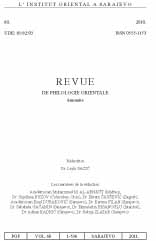Koncept dobročinstva i poreska oslobođenja u Osmanskom carstvu
Concept of benefaction and tax exemptions in the Ottoman Empire
Author(s): Fahd KasumovićSubject(s): History
Published by: Orijentalni Institut u Sarajevu
Keywords: Ottoman Empire; Bosnia; Sarajevo; 18th.and 19t.h centuries; benefaction; taxation; tax exemption; in'amat defters
Summary/Abstract: Ottoman conception of importance of benefaction in governing the state was a continuation of ideas developed and shaped in the Muslim Middle East during the Middle Ages. Interestingly enough, sultans considered the granted tax exemptions as an expression of their benevolence, kindness and grace, in the same way as numerous other decisions they were taking on various matters. Apart from this, administrative officials were also finding out ways to publicly demonstrate benevolence. Governors of Bosnia in the 18th and first half of the 19th centuries, under the name of in'am (benefaction, gift), used to grant, mostly at individual level, long-term rights to deduction (i.e. partial tax exemptions) of tax amount which had been, in accordance with the repartition register, twice a year, apportioned to each tax payer as his tax share of imdad-i hazariyye and other surtaxes and fees that were listed in the register. Governor’s “gifts” of tax deduction were registered in in-amat defters, together with governor’s gifts in form of long-term cash subventions that were paid to individuals every time after the each imdad-i hazariyye instalment had been collected. The tax deduction right could be inherited by heirs. Also, it could be abandoned and in return of an agreed upon equivalent transferred to the interested party. Therefore, tax deductions, designated in sources as in'am, represent very interesting taxation phenomena in the Ottoman Empire. In other parts of the Empire we have no information on existence of in'amat defters which would be similar to those of Bosnia’s governors, but we are acquainted with different uses of the term of in'am, as in taxation, so in other fields. Of course, that could be because the mentioned question has not been researched. However, the phenomena in question, apparently, was not widespread, but rather, a local characteristic of certain areas in the Ottoman Empire. According to the current findings, these areas include the kaza of Sarajevo, as well as few other nahiye in the Eyalet of Bosnia.
Journal: Prilozi za orijentalnu filologiju
- Issue Year: 2011
- Issue No: 60
- Page Range: 259-309
- Page Count: 51
- Language: Bosnian

